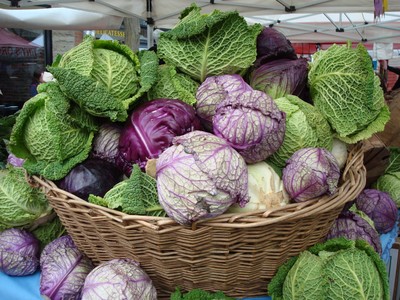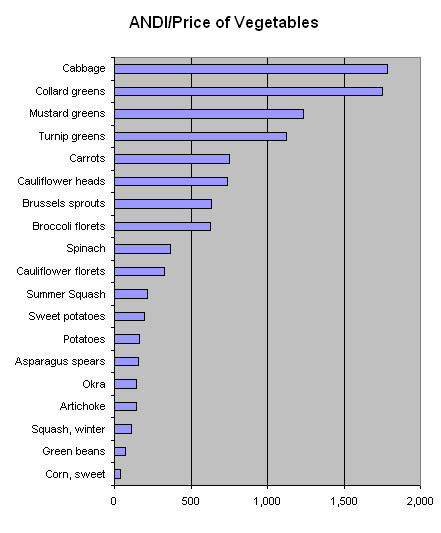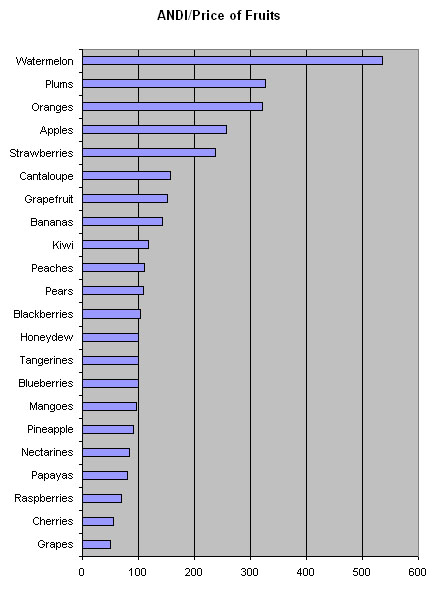 Yesterday, Jen posted on getting the most bang for your buck in the produce section. By comparing the price-per-cup of various fruits and vegetables to their ANDI score, she arrived at a rough ranking of the best, cheapest sources to get your vitamins.
Yesterday, Jen posted on getting the most bang for your buck in the produce section. By comparing the price-per-cup of various fruits and vegetables to their ANDI score, she arrived at a rough ranking of the best, cheapest sources to get your vitamins.
(Note: neither of us is totally sold on the ANDI scoring method, but it at least provides some food for thought—pardon my pun.)
She didn’t have time to track down the whole list, but I did.
Here are veggies:

And here are fruit:

(Note: These figures were arrived at by dividing each item’s ANDI score by the average price per pound provided by the USDA—found here in Jen’s post.)
Jen already highlighted the smart choices: cabbage, leafy greens, carrots, and cauliflower for veggies, and watermelon, plums, oranges, and apples for fruit.
What shouldn’t you waste your money on? I wasn’t surprised to see corn on the bottom—fresh corn is often expensive and it’s starch-laden interior lacks much in the way of nutrients. Green beans, winter squash, and artichokes all ended up at the bottom, too. Potatoes didn’t rank as badly as I expected, but that’s just because they’re so darn cheap.
For fruit, grapes came in dead last—not shocking since they’re largely water. The most expensive fruit, raspberries, came in third, and despite being cheap nectarines landed in fifth.
For the most part, it’s all pretty intuitive. The things Mom always tried to get us to eat—like greens and brussels sprouts—look pretty good. But let’s be honest: if you’re fretting the choice between broccoli and okra—and not between Cap’n Crunch and SpaghettiO’s—you’re already way ahead of the curve.
Cabbage photo by Sightline staffer Migee Han.









Matt the Engineer
What, no beets?What’s nice about the vegi list is that everything at the top of the list is easily grown in the Pacific Northwest. My winter bin (I highly recommend Nash’s) is generally filled with cabbage, brussels sprouts, beets, turnips, apples, and sunchokes.
Matt the Engineer
Oh, and regarding “For fruit, grapes came in dead last—not shocking since they’re largely water.” What was shocking (to me, anyway) was that watermellon is at the top of the list! I assumed they were mostly water and would be lower. Then again, they’re really cheap when in season.
Elaine
still no tomatoes?
Eric Hess
Re: beets and tomatoes: Unfortunately, the USDA price averages Jen dug up don’t include tomatoes, so it’s hard to say because I don’t know how much tomatoes cost per pound on average, nationwide. If you assumed a cost of $1.50/lb, they’d fall very low on the chart for veggies (below winter squash), and midway on the fruit chart (below pears).Re: watermelon: part of it is how darn cheap they are, but they apparently have more nutrients than I thought. They have an ANDI score of 91, placing them better than peaches, apples, mangoes, bananas, and a bunch of other fruit. Who knew?
Jennifer Langston
Tomatoes are in the USDA’s raw veggie chart, and nationally price out at about $1.24/lb. So that puts them roughly next to sweet potatoes on the veggie chart and cantaloupe on the fruit chart.I don’t what the USDA has against beets, but they don’t seem to be included in their price charts.
jonesey
This analysis is just begging for an iphone or web app where you could put in the price per pound that you’re considering paying for a given fruit or veggie, and get a score per dollar.Prices vary a lot for some fruits and veggies, depending on whether the fruit is in season or not—the price difference from frozen blueberries to out-of-season blueberries from Chile to in-season fresh blueberries to u-pick blueberries probably ranges through a factor of 5-10. And the app could include ANDI scores for Cap’n Crunch and Spaghetti-Os, to show you that cheap food isn’t really cheap.Michael Pollan needs to team up with some software nerds.
Matt the Engineer
Now even Eric forgot about beets while he was actually writing about beets! Poor neglected vegetable.I’ll take up their cause. Amazon Fresh sells them for $3 for 4 beets (with beet greens, but we’ll ignore those for now). Guessing this is about a pound of beets, that’s $3/lb. The ANDI score is 97 for 1.5 cups of cooked beets. I’d guess a bunch of beets gives you what – 4.5 cups? I suppose that depends if you stir-fry, bake, or boil them. So that’s 291/$3 = 97. So that’s somewhere around winter squash, so kind of terrible. So much for the assumption that more color = more nutrients.Of course I’ve ignored the beet greens, but then Google can’t find and ANDI score for them.
civiletti
Vitamins, of course, are not all we need from food, and they can be gotten inexpensively from supplements. There’s protein, healthy fats, carbs, many anti-oxidants not considered vitamins, fiber, etc. Still, I think the list of veggies is somewhat useful, though I think winter squash and sweet potato are worth more than their ratings. The fruit list is generally misleading, IMHO. Watermelon really is almost all water [hence the name] and berries are full of powerful anti-oxidants.
Maryn
I think this is an interesting way of thinking about food choices. Of course if you are already convinced that quality food is the source of life, pricing is not the issue. But for people that think good, nutritious food is expensive, this is another way of thinking about food choices. I would love to see more thought and discussion on this and the handy chart that can be given to people as a basic guide.
Lorien Mahay
I just wanted to thank you for this awesome post! I am trying to make better choices on a very low budget right now and this chart really helps to visualize what produce would give me the most bang for my buck. I liked it so much that I suggested people check this post out on my own site http://www.defenderofthecube.com. Keep up the good work!